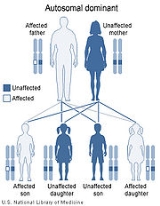
Pachyonychia congenita
Encyclopedia
Pachyonychia congenita, also called Jadassohn-Lewandowski Syndrome or simply pachyonychia, is an autosomal dominant skin disorder.
that encode keratin
protein
s specific to the epithelial tissues affected in the two forms of the disorder. PC1 is caused by mutations in keratin 6A
(protein name K6A; gene name KRT6A) or keratin 16
(protein K16; gene KRT16). The PC2 form is due to mutations in the genes encoding keratin 6B
(protein name K6B; gene name KRT6B) or keratin 17
(protein K17; gene KRT17). Three of the genes causing PC were identified in 1995 with the fourth gene following in 1998.
 Pachyonychia congenita follows an autosomal dominant pattern of inheritance, which means the defective gene is located on an autosome
Pachyonychia congenita follows an autosomal dominant pattern of inheritance, which means the defective gene is located on an autosome
, and only one copy of the gene is required to inherit the disorder from a parent who has the disorder. On average, 50% of the offspring of an affected person will inherit the disorder, regardless of gender.
Occasionally, however, a solitary case can emerge in a family with no prior history of the disorder due to the occurrence of a new mutation
(often referred to as a sporadic or spontaneous mutation).
Symptoms
Common symptoms include:- Excess keratin in nail beds and thickening of the nails
- HyperkeratosisHyperkeratosisHyperkeratosis is thickening of the stratum corneum, often associated with a qualitative abnormality of the keratin, and also usually accompanied by an increase also in the granular layer...
on hands and feet - Oral lesions that look like thick white plaques
- Steatocystoma multiplex
- Pain
- Blisters
Types
Pachyonychia congenita may be divided into the following types:- Pachyonychia congenita type IPachyonychia congenita type IPachyonychia congenita type I is an autosomal dominant keratoderma that principally involves the plantar surfaces, but also with nails changes that may be evident at birth but more commonly develop within the first few months of life.- See also :* Palmoplantar keratoderma* List of cutaneous...
- Pachyonychia congenita type IIPachyonychia congenita type IIPachyonychia congenita type II is an autosomal dominant keratoderma presenting with a limited focal plantar keratoderma that may be very minor, with nails changes that may be evident at birth, but more commonly develop within the first few months of life....
Pathophysiology
The condition is caused by genetic mutations in one of four genesGênes
Gênes is the name of a département of the First French Empire in present Italy, named after the city of Genoa. It was formed in 1805, when Napoleon Bonaparte occupied the Republic of Genoa. Its capital was Genoa, and it was divided in the arrondissements of Genoa, Bobbio, Novi Ligure, Tortona and...
that encode keratin
Keratin
Keratin refers to a family of fibrous structural proteins. Keratin is the key of structural material making up the outer layer of human skin. It is also the key structural component of hair and nails...
protein
Protein
Proteins are biochemical compounds consisting of one or more polypeptides typically folded into a globular or fibrous form, facilitating a biological function. A polypeptide is a single linear polymer chain of amino acids bonded together by peptide bonds between the carboxyl and amino groups of...
s specific to the epithelial tissues affected in the two forms of the disorder. PC1 is caused by mutations in keratin 6A
Keratin 6A
Keratin 6A is a protein that in humans is encoded by the KRT6A gene.- Keratins :Keratins are the intermediate filament proteins that form a dense meshwork of filaments throughout the cytoplasm of epithelial cells. Keratins form heteropolymers consisting of a type I and a type II keratin...
(protein name K6A; gene name KRT6A) or keratin 16
Keratin 16
Keratin 16 is a protein that in humans is encoded by the KRT16 gene.Keratin 16 is a type I cytokeratin. It is paired with keratin 6 in a number of epithelial tissues, including nail bed, esophagus, tongue, and hair follicles...
(protein K16; gene KRT16). The PC2 form is due to mutations in the genes encoding keratin 6B
Keratin 6B
Keratin 6B is a type II cytokeratin, one of a number of isoforms of keratin 6. It is found with keratin 16 and/or keratin 17 in the hair follicles, the filiform papillae of the tongue and the epithelial lining of oral mucosa and esophagus. This keratin 6 isoform is thought be less abundant than the...
(protein name K6B; gene name KRT6B) or keratin 17
Keratin 17
Keratin, type I cytoskeletal 17 is a protein that in humans is encoded by the KRT17 gene.Keratin 17 is a type I cytokeratin. It is found in nail beds, hair follicles, sebaceous glands, and other epidermal appendages...
(protein K17; gene KRT17). Three of the genes causing PC were identified in 1995 with the fourth gene following in 1998.
Inheritance

Autosome
An autosome is a chromosome that is not a sex chromosome, or allosome; that is to say, there is an equal number of copies of the chromosome in males and females. For example, in humans, there are 22 pairs of autosomes. In addition to autosomes, there are sex chromosomes, to be specific: X and Y...
, and only one copy of the gene is required to inherit the disorder from a parent who has the disorder. On average, 50% of the offspring of an affected person will inherit the disorder, regardless of gender.
Occasionally, however, a solitary case can emerge in a family with no prior history of the disorder due to the occurrence of a new mutation
Mutation
In molecular biology and genetics, mutations are changes in a genomic sequence: the DNA sequence of a cell's genome or the DNA or RNA sequence of a virus. They can be defined as sudden and spontaneous changes in the cell. Mutations are caused by radiation, viruses, transposons and mutagenic...
(often referred to as a sporadic or spontaneous mutation).

